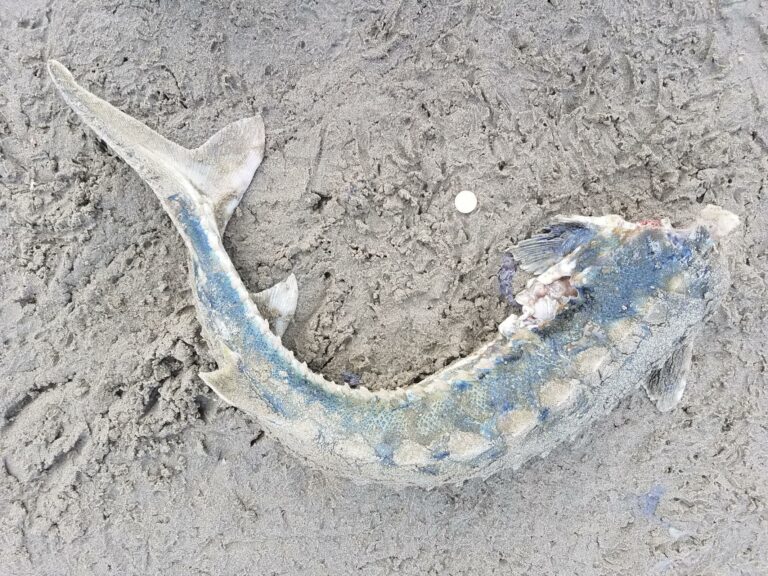Mile 203 Report
Driftwood Beach south, Hidden Lake
May 25, 2020
Shoreline Wildlife - We found, we believe, a dead sturgeon on the shore without its head.
Report Details
Shoreline Wildlife - We found, we believe, a dead sturgeon on the shore without its head. We have included a picture with a penny for size reference.We picked up two 2.5 gallon buckets of ocean debris. Pictures show bucket and examples of the debris
Conditions
Temperature: 54 F. Wind Velocity: Calm/Light. Wind Direction: NW. Tide Level: 5.1 feet.
Human Activities
Number of people: 34. Number of dogs: 15. Walking or running: 23. Playing in sand: 7. Sitting: 4. The people walking disturbed small groups of shore birds who were feeding. The people were not trying to disturb the birds.
Concerns
Disturbances: Shorebirds moving in response to humans/dogs
Notable Wildlife
There were small groups of migratory shore birds. I could not get close enough to identify or photograph them. They are a medium sized sandy brown colored bird with straight 3 to 4 inch beaks. They are on the beach in fall and spring. The crows do not like them around and hop at them.
Beached Birds
Total dead birds: 10. The carcasses were very decomposed. Some were a pile of bones and some feathers. Most seemed to have been eaten.
Dead Fish or Invertebrates
A few days earlier we found what looks like a dead sturgeon with it's head bit off. We have never seen or heard of one showing up on this beach. See picture. We placed a penny near the carcass for size reference.
Driftline Content
Small rocks, Shells, Animal casings (e.g., crab, shrimp molt), Wood pieces, Marine debris (plastic, styrofoam, etc. washing in from the sea), Styrofoam, Ocean-based debris (from fishing boats, ship trash, etc.).
Actions & Comments
The summer sand dunes are starting to form on the north end of our mile. As the wind shifts to the northwest the sand tends to change where it piles up. Also, an outer sand pile has started forming on the shore line which creates a ponding of water inside of the sand pile from the ocean. This pond which can run north and south for a half mile or more by the end of August holds water and small dead mole crabs and other debris the waves washes into it. Birds like to feeed there until the water becomes too stagnet which then starts to smell.



Report Images
All Mile 203 Reports
Mile 203
Driftwood Beach south, Hidden Lake
We found 7 lbs 12 oz of marine and ocean debris on the beaches in the wrackline area. The north and south ends of mile 203 show evidence of substantial wave erosion of the dunes.
Jeff Hildreth
Mile 203
Driftwood Beach south, Hidden Lake
The beach has had substantial washing away of old dunes and washing up of beach grass into the dunes. There were 45 bird carcasses of we believe are Cassin's auklets.
Jeff Hildreth
Mile 203
Driftwood Beach south, Hidden Lake
Today I and my two CoastWatch partners conducted a NOAA Marine Debris survey on our 100 meter survey site at Sandpiper Beach, Mile 203. On reaching our marine debris survey site, we saw a lot of Cassin's Auklet carcasses, which COASST calls CAAU, all high up on the beach among the beach vegetation and washed-in sea grass, many carcasses partially covered by sand or vegetation. After we completed our debris survey, I returned to our survey site and began collecting CAAU carcasses in groups of 9, as COASST recommends, ultimately collecting 40 carcasses in 4 full and 1 partial grouping. Below is a link to our Sandpiper Beach NOAA debris survey site where most CAAUs were found, reached by a boardwalk that enters the beach midway in the debris survey site. COASST defines a "wreck" as more than 20 beached individuals of one species per kilometer, and a "MME" (Massive Mortality Event) as a spike of up to hundreds of carcasses per kilometer. We also found a beached Northern Fulmar and what is I believe was either a female Gadwall or White-winged Scoter, which I took note of but didn't measure or report on to COASST. I submitted documentation with photos of the CAAU beaching event to COASST, and COASST responded that they had received reports of CAAU beachings from Southern Oregon sites like Coquille Point and Cape Blanco but also as far north as Manzanita. All this sounds very dry, but it was really sad to see and handle all these beautiful little dead birds and wonder if this is completely natural or if climate change, and perhaps a decline of prey species making these birds more vulnerable, factors into these mortality events. https://mdmap.
Jon French
Mile 203
Driftwood Beach south, Hidden Lake
The storms and rain caused some beach washout from the ocean and from the land.
JLcoasties
Mile 203
Driftwood Beach south, Hidden Lake
The dunes have reappeared due to the spring winds.
JLcoasties
Mile 203
Driftwood Beach south, Hidden Lake
Last year at this time, Jesse Jones helped us set up a 100 meter NOAA marine debris survey site on Mile 204, which we later moved to Sandpiper Beach on Mile 203.
Jon French
Mile 203
Driftwood Beach south, Hidden Lake
It was a beautiful day for a walk.
Nancy Thomas
Mile 203
Driftwood Beach south, Hidden Lake
After observing 8 snowy plovers on Mile 200 yesterday, I wanted to check up on the plovers on Mile 203.
KFunk








